What's the best oil for YOUR Shelby, answers within.
#1
As many of you know, I read about engine lubricant technology daily. We have discussed what is the proper engine lubricant to use in your Shelby GT500. I decided to use an online viscosity calculator to map out the viscosity range of 4 different lubricants that were discussed in previous posts by myself, and other members on this board.
The reason for this thread. Some have questioned my previous choice of Amsoil 20W-50 and current choice of Amsoil 10W-40. Some thought it was "too heavy" for a "20W" or "10W" winter weight, and that a 5W-50 was a much better choice to avoid cold start up wear (besides, Ford knows best, right?). Guess what, SAE grade ratings for engine lubricants are very misleading. Let's take a look at the chart that was calculated for me at Widman.
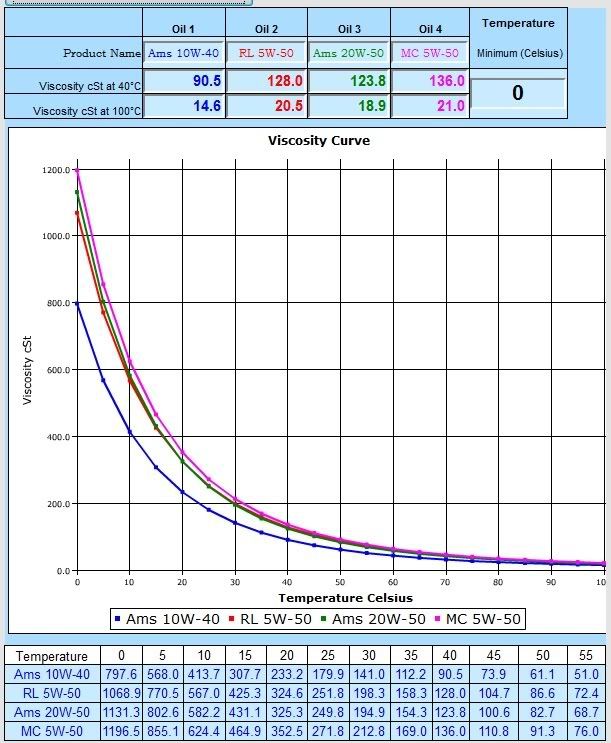
Graph @ 0*C (32*F)
If you pay close attention to the chart, you will clearly see that Amsoil 20W-50 is slightly more viscous than Red Line 5W-50 at 0*C, but less viscous than Motorcraft 5W-50. Do you see one of the advantages of a true group IV synthetic base stock? Do you recall that my sample of Amsoil 20W-50 only sheared 8% in 2,000 miles, but all the Motorcraft and Castrol samples sheared ~25-35% in the same miles of use? See info below.
cSt@100*C
Amsoil - Virgin (18.9) 2,000 miles (17.5)
Motorcraft - Virgin (21.0) 2,000 miles (~12.89-13.5)
Now take a look at my current fill of Amsoil 10W-40. You would think that a "10W" oil would be thicker at 0*C (32*F) than a "5W". It's by far lighter, and much better for cold start up wear, than any of the other three lubricants. I say again, SAE oil grade numbers are very misleading. Amsoil 10W-40 will achieve it's at temperature rated viscosity much faster than any of the other three lubricants. Yes, this means less engine start up wear.
I will be taking my first sample of 10W-40 this week as I have completed the first 2,000 miles. Then I will compose a new calculated chart showing all of the oils after shearing has taken place. You will then see how light Motorcraft and Castrol 5W-50 gets, yet Amsoil retains it's viscosity.
UPDATE:
I made a new chart with results from UOAs after ~2,000 miles. One sample of Amsoil 20W-50 and three different samples of Motorcraft 5W-50.

You can see how Amsoil retained it's virgin viscosity far better than Motorcraft. This is a huge plus for a true group IV base stock and why they can be used for longer periods of time, while also providing better protection.
Now, this is a chart I did to compare the three used Motorcraft samples (~2,000 miles) versus a virgin sample of Amsoil 10W-40.
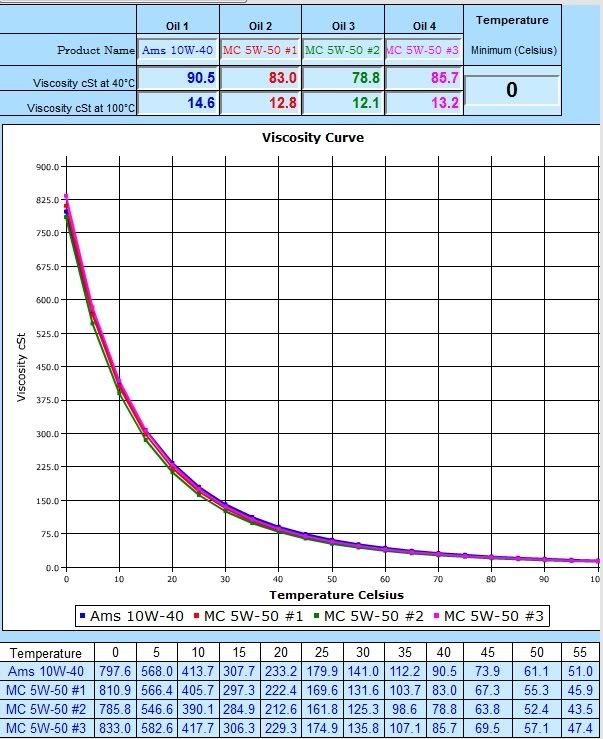
Do you see how close they are? Since Amsoil shears far less than Motorcraft, does everyone now see WHY I have chosen to use Amsoil 10W-40? Why select a lubricant that will shear when I can protect my engine better with a lubricant than will remain close to its virgin specs?
I hope this helps those who were in doubt to see the light.
UPDATE: 3/9/2011
The UOA for Amsoil 10W-40 has returned, and everything is working out just fine.
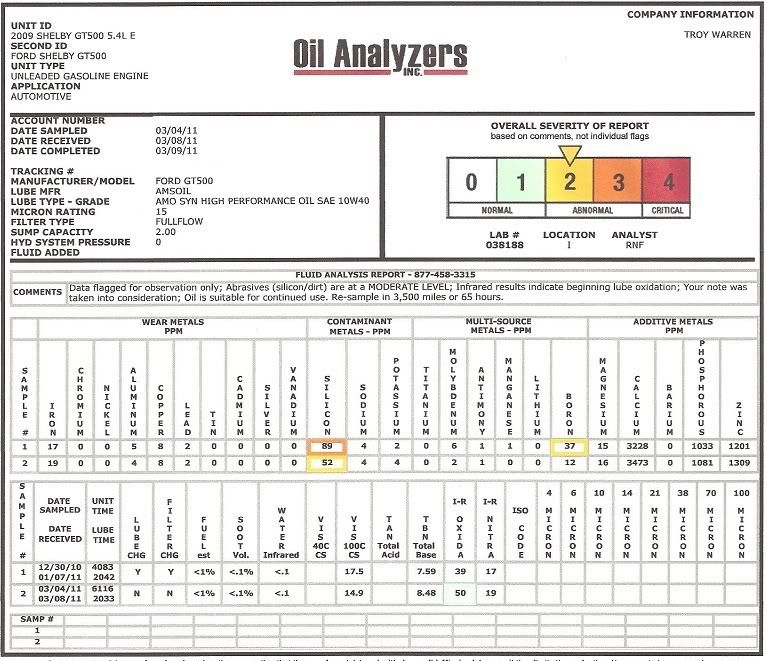
Sample #1 was Amsoil 20W-50 from the previous sample run
Sample #2 was Amsoil 10W-40 from the current sample run (this oil is still in the sump, only a sample was taken with a pump from the dip stick tube)
Iron, Copper, Lead and Aluminum:
the wear numbers are consistent with the previous fill of 20W-50. In fact, my car was raced more (and harder) on the fill of 10W-40 than it was on 20W-50.
Silicon:
I see a reduction in the ppm content of silicon, about 37 ppm less, but still not what I expected. I was hoping to see normal content around 15 ppm. Yes, it's a big reduction from the previous sample of 89 ppm, so that tells me the new Amsoil EaU air filter is doing the job better than the oiled wet gauze type filter I was using prior. I'm curious if the higher ZDDP formulations of Amsoil 10W-40 and 20W-50 have higher amounts of silicon in the virgin sample. I know their lower viscosity passenger car formulations have ~10 ppm of silicone in virgin samples.
Although, even though I'm not 100% satisfied with the outcome of the silicon report, it's still world's better than any other UOA I have seen from other GT500s. Other UOAs have silicon content ranging from 150-300 ppm in engines with similar mileage. I do have a sample from a GT500 using Castrol 5W-50, the silicon was only 24 ppm, but the engine had 10,500 miles at the time the sample was taken. This may be evidence that the high levels of silicon in the 5.4L engine are in fact due to the manufacturing process, and it takes a few oil changes to remove the bulk of it. The jury is still out, and I will have to wait until I drain the sump, refill again, and then get a UOA with some miles in it.
Boron:
Why are they flagging Boron? It's native in the virgin samples of Amsoil. This time less than before.
ZDDP:
Good levels of anti-wear additive here, and plenty to go another UOA. In fact, even higher than the last sample.
Viscosity:
This is where I am most pleased. Amsoil 10W-40 did exactly what I expected it too.....it didn't shear at all (not even 1%). Amsoil spec's this lubricant in virgin samples to be 14.6, this sample measured in at 14.9. This is great news, and backs up my theories of superiority over Motorcraft, Castrol, and Mobil 5W-50.
TBN:
Detergent additives, still strong, and even better than the first sample. This lubricant has many more miles to go before a change in required.
Oxidation:
They flagged this as green (normal). Amsoil lubricants will have an oxidation reading around 25-30 on fresh non-used oil. 50 is still in the usable range. I will of course be keeping an eye on this area for the next sample.
Final thoughts:
Overall, this sample of Amsoil 10W-40 performed just as well as the previous fill of 20W-50. In fact, in the viscosity (shearing), ZDDP, and TBN areas, it was superior. The prior UOA report was deemed "normal". I believe this report to be mis-marked "abnormal". The silicon content is why it was marked as a level 2, and not level 1 (even though it's the lowest silicon ppm in any Shelby UOA with similar miles). I'm leaving this sample in the 5.4L for another 2,000 miles. We will see how well it holds up to a 4,000 mile interval.
UPDATE 6/19/2011: AMSOIL STILL MAINTAINS IT'S VIRGIN VISCOSITY AFTER 4,124 MILES!!!
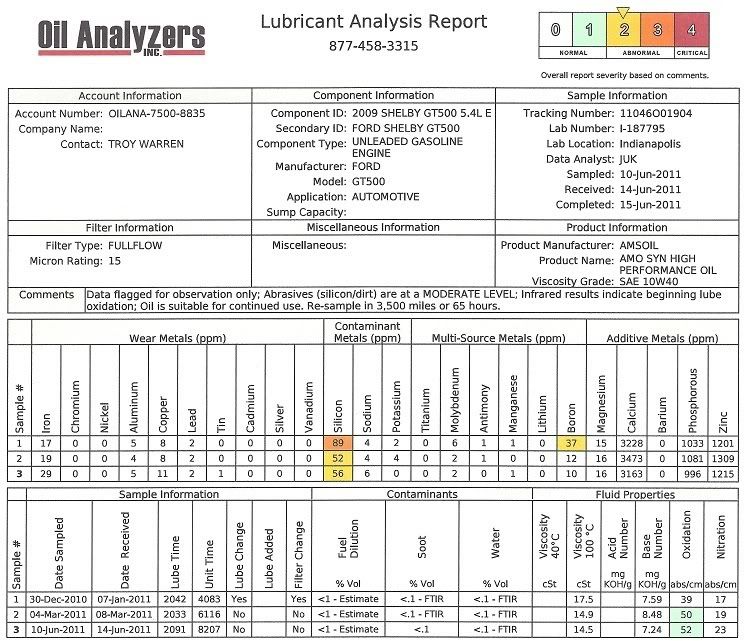
Let's begin with a mistake I made filling out the form. I forgot to add together the total miles of the first interval plus the second, I only added up the difference from the first interval to the second. My stupid mistake. Actual miles on the second interval is 4,124, not 2,091 as I wrote on the form.
Iron:
In the near future, I plan to send in a virgin sample of Amsoil 10W-40 to see what the virgin specs actually are. This would answer a few questions I and others have about this lubricant.
Let the questions and comments begin. I'm here to help you better protect your $50,000+ investment.
UPDATE: 9/30/2011
UOA chart updated yet again in post #1
I'm shocked at how fast the results are in. The sample was just sent off via UPS on Tuesday afternoon. WOW! Good job Polaris Labs. :thumbsup:
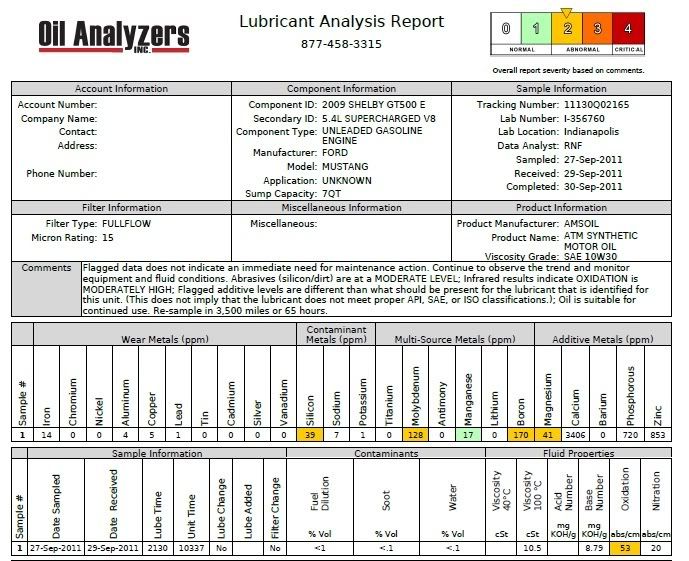
Lab technicians do not think sometimes, but I can't blame them....they don't know the vehicle as well as I do, and have to test so many samples, so I decided to clarify some things.
Really? If you would look at the three previous samples taken from this engine, you would have seen that the silicon levels are declining after every oil change. This is due to the sealants used to assemble the engine, and not dust contamination from a faulty air filter.
How can you make that assumption without a virgin sample from the same batch? This is the normal range for PAO synthetics. :dw:
That's because you have the virgin specs for the old Amsoil 10W-30. The new signature series 10W-30 had a big change in the additive package. ZDDP was reduced, Moly and Boron were added to compensate. If they had the new specs...Moly, Boron, and Magnesium would not be flagged, as it's native to the virgin sample. Finally I have more solid proof that Moly and Boron is a great substitute for lower levels of ZDDP.
Manganese is flagged for a good reason. This is what happens when you use Torco. The more you use, the higher ppm this will be.
Now that we have that out of the way....check out how beautiful the metal wear numbers are. I'm very happy with these results, and so far are the best from any sample in the list, my previous samples included. Amsoil 10W-30 is dominating the performance in my engine, and the oil pressure in my car is slightly improved over 10W-40. I can only imagine the improvement over un-sheared 5W-50.
Virgin Amsoil 10W-30 viscosity is 10.5 cSt...and it remained exactly that...10.5 (zero % shearing).
TBN is still over 8, so that means this lubricant could be used for many more miles.
Retesting when the car is slightly over 12,000 miles.
Here is a detailed UOA Excel spreadsheet I have created to compare the performance of different lubricants in the Shelby 5.4L engine.


Base green color samples are random UOAs waiting for a follow up.
Other "like" color groupings are samples taken from the same engine.
The reason for this thread. Some have questioned my previous choice of Amsoil 20W-50 and current choice of Amsoil 10W-40. Some thought it was "too heavy" for a "20W" or "10W" winter weight, and that a 5W-50 was a much better choice to avoid cold start up wear (besides, Ford knows best, right?). Guess what, SAE grade ratings for engine lubricants are very misleading. Let's take a look at the chart that was calculated for me at Widman.

Graph @ 0*C (32*F)
If you pay close attention to the chart, you will clearly see that Amsoil 20W-50 is slightly more viscous than Red Line 5W-50 at 0*C, but less viscous than Motorcraft 5W-50. Do you see one of the advantages of a true group IV synthetic base stock? Do you recall that my sample of Amsoil 20W-50 only sheared 8% in 2,000 miles, but all the Motorcraft and Castrol samples sheared ~25-35% in the same miles of use? See info below.
cSt@100*C
Amsoil - Virgin (18.9) 2,000 miles (17.5)
Motorcraft - Virgin (21.0) 2,000 miles (~12.89-13.5)
Now take a look at my current fill of Amsoil 10W-40. You would think that a "10W" oil would be thicker at 0*C (32*F) than a "5W". It's by far lighter, and much better for cold start up wear, than any of the other three lubricants. I say again, SAE oil grade numbers are very misleading. Amsoil 10W-40 will achieve it's at temperature rated viscosity much faster than any of the other three lubricants. Yes, this means less engine start up wear.
I will be taking my first sample of 10W-40 this week as I have completed the first 2,000 miles. Then I will compose a new calculated chart showing all of the oils after shearing has taken place. You will then see how light Motorcraft and Castrol 5W-50 gets, yet Amsoil retains it's viscosity.
UPDATE:
I made a new chart with results from UOAs after ~2,000 miles. One sample of Amsoil 20W-50 and three different samples of Motorcraft 5W-50.

You can see how Amsoil retained it's virgin viscosity far better than Motorcraft. This is a huge plus for a true group IV base stock and why they can be used for longer periods of time, while also providing better protection.
Now, this is a chart I did to compare the three used Motorcraft samples (~2,000 miles) versus a virgin sample of Amsoil 10W-40.

Do you see how close they are? Since Amsoil shears far less than Motorcraft, does everyone now see WHY I have chosen to use Amsoil 10W-40? Why select a lubricant that will shear when I can protect my engine better with a lubricant than will remain close to its virgin specs?
I hope this helps those who were in doubt to see the light.
UPDATE: 3/9/2011
The UOA for Amsoil 10W-40 has returned, and everything is working out just fine.

Sample #1 was Amsoil 20W-50 from the previous sample run
Sample #2 was Amsoil 10W-40 from the current sample run (this oil is still in the sump, only a sample was taken with a pump from the dip stick tube)
Iron, Copper, Lead and Aluminum:
the wear numbers are consistent with the previous fill of 20W-50. In fact, my car was raced more (and harder) on the fill of 10W-40 than it was on 20W-50.
Silicon:
I see a reduction in the ppm content of silicon, about 37 ppm less, but still not what I expected. I was hoping to see normal content around 15 ppm. Yes, it's a big reduction from the previous sample of 89 ppm, so that tells me the new Amsoil EaU air filter is doing the job better than the oiled wet gauze type filter I was using prior. I'm curious if the higher ZDDP formulations of Amsoil 10W-40 and 20W-50 have higher amounts of silicon in the virgin sample. I know their lower viscosity passenger car formulations have ~10 ppm of silicone in virgin samples.
Although, even though I'm not 100% satisfied with the outcome of the silicon report, it's still world's better than any other UOA I have seen from other GT500s. Other UOAs have silicon content ranging from 150-300 ppm in engines with similar mileage. I do have a sample from a GT500 using Castrol 5W-50, the silicon was only 24 ppm, but the engine had 10,500 miles at the time the sample was taken. This may be evidence that the high levels of silicon in the 5.4L engine are in fact due to the manufacturing process, and it takes a few oil changes to remove the bulk of it. The jury is still out, and I will have to wait until I drain the sump, refill again, and then get a UOA with some miles in it.
Boron:
Why are they flagging Boron? It's native in the virgin samples of Amsoil. This time less than before.
ZDDP:
Good levels of anti-wear additive here, and plenty to go another UOA. In fact, even higher than the last sample.
Viscosity:
This is where I am most pleased. Amsoil 10W-40 did exactly what I expected it too.....it didn't shear at all (not even 1%). Amsoil spec's this lubricant in virgin samples to be 14.6, this sample measured in at 14.9. This is great news, and backs up my theories of superiority over Motorcraft, Castrol, and Mobil 5W-50.
TBN:
Detergent additives, still strong, and even better than the first sample. This lubricant has many more miles to go before a change in required.
Oxidation:
They flagged this as green (normal). Amsoil lubricants will have an oxidation reading around 25-30 on fresh non-used oil. 50 is still in the usable range. I will of course be keeping an eye on this area for the next sample.
Final thoughts:
Overall, this sample of Amsoil 10W-40 performed just as well as the previous fill of 20W-50. In fact, in the viscosity (shearing), ZDDP, and TBN areas, it was superior. The prior UOA report was deemed "normal". I believe this report to be mis-marked "abnormal". The silicon content is why it was marked as a level 2, and not level 1 (even though it's the lowest silicon ppm in any Shelby UOA with similar miles). I'm leaving this sample in the 5.4L for another 2,000 miles. We will see how well it holds up to a 4,000 mile interval.
UPDATE 6/19/2011: AMSOIL STILL MAINTAINS IT'S VIRGIN VISCOSITY AFTER 4,124 MILES!!!

Let's begin with a mistake I made filling out the form. I forgot to add together the total miles of the first interval plus the second, I only added up the difference from the first interval to the second. My stupid mistake. Actual miles on the second interval is 4,124, not 2,091 as I wrote on the form.
Iron:
Only 10 ppm increase in 2,000 miles shows a decline in wear from previous UOAs. A 2,000 mile interval would yield twice as much iron ppm from previous samples. I can't attribute this entirely to Amsoil, as the engine is reaching its break in point. It should naturally yield lower wear metals as the engine nears 10,000 miles. Now, I can attribute lower wear metals in the pre-break in periods of my engines life using a true synthetic versus similar UOAs viewed using other engine lubricants.
I was worried that the 170* thermostat would increase wear due to a cooler combustion chamber (the chamber could potentially expand less due to lower heat causing decreased piston ring to cylinder wall clearance. After this report, I'm not worried about it anymore.
Aluminum, Copper, Lead, Tin:I was worried that the 170* thermostat would increase wear due to a cooler combustion chamber (the chamber could potentially expand less due to lower heat causing decreased piston ring to cylinder wall clearance. After this report, I'm not worried about it anymore.
Levels of these wear metals barely increased, Lead not at all. No strange numbers to be worried about here. I'm very satisfied with this UOA, but still more to discuss.
Silicon:This is why the sample is flagged as "abnormal", but still satisfactory for extended use. If you read the message to "test another 3,500 miles", you will see there is still plenty of life left in this lubricant.
There was a 4 ppm increase from the last sample sent in for testing. This is less than I could have ever imagined. Shelby GT500 engines have silicon ppm around 200+ from the first sample of oil that is drained from a brand new engine. It's dirt/dust that was trapped inside from the assembly process. This ppm decreases every oil change as the dirt/dust is cleaned/washed away by the lubricant and relocated to the oil filter, or drained with the used oil due to silicon being trapped in suspension of the base stock. Since I have not changed my oil, continued testing on the same fill, I was shocked to see the silicon content had only increased 4 ppm. What does this mean? It means the Amsoil nano fiber air filter is doing a kick butt job at filtering the air intake. Honestly, I don't recall ever seeing a silicon ppm of any car with a 2-3,000 mile interval less than 11 ppm. No way would an oiled cotton media filter perform this well (with the exception to Air Raid's new 2010-11 GT500 filters. Their oiled filter has an extra synthetic layer to catch what the oil may miss.)
ZDDP (Zinc and Phosphorous):API SN lubricants are capped at a maximum of 900 ppm phosphorous. This sample after 4,124 miles still has more than a virgin sample of an API SN formulation with 996 ppm. Since ZDDP is a primary anti-wear additive, this is a factor of minimizing wear. More anti-wear agents seems to equal less wear in this engine. You won't find these levels of ZDDP in any passenger car lubricant that is API SM or SN certified, and why I refuse to buy them.
Viscosity:This lubricant's virgin spec is 14.6 (not personally tested), was 14.9 in the previous sample, and 14.5 in this sample. The problem is I didn't ever send in a virgin sample of Amsoil 10W-40 to see what the actual virgin viscosity is. Despite knowing true virgin specs, this UOA still shows that Amsoil 10W-40 is holding its viscosity of a 40 grade. It doesn't shear to a lighter viscosity like Motorcraft or Castrol 5W-50.
Total Base Number (detergent additives):This determines how much active additive remains in the lubricant to "clean" the engine and combat contaminants from fuel, soot, sludge, etc. The TBN of this sample at 4,124 miles rivals some off the shelf lubricants that are still in the bottle (virgin). This is one reason why the lab want's to test the oil again in 3,500 miles, although....there is much more life left in this oil beyond 3,500 miles.
Oxidation (base stock degradation):This is a topic that Six Speed and myself were discussing on the previous UOA sample. It's marked "green" and considered in "beginning base stock oxidation stage", but was a bit higher than the sample of Amsoil 20W-50 previously tested. I was shocked to see the oxidation levels higher in similar formulated lubricants. The good news is, it isn't oxidizing at a rapid pace. Again, a virgin sample of Amsoil 10W-40 needs to be analyzed for comparison.
In conclusion, I've extremely happy with the results despite the oxidation questions I have. I wish Blackstone lab would include oxidation testing in their reports so I could compare this specification to other used samples. I wanted to share this with the fellow oil followers to show how well Amsoil 10W-40 was performing in the 5.4L supercharged mill. In the near future, I plan to send in a virgin sample of Amsoil 10W-40 to see what the virgin specs actually are. This would answer a few questions I and others have about this lubricant.
Let the questions and comments begin. I'm here to help you better protect your $50,000+ investment.
UPDATE: 9/30/2011
UOA chart updated yet again in post #1
I'm shocked at how fast the results are in. The sample was just sent off via UPS on Tuesday afternoon. WOW! Good job Polaris Labs. :thumbsup:

Lab technicians do not think sometimes, but I can't blame them....they don't know the vehicle as well as I do, and have to test so many samples, so I decided to clarify some things.
Abrasives (silicon/dirt) are at a MODERATE LEVEL;
Infrared results indicate OXIDATION is
MODERATELY HIGH;
MODERATELY HIGH;
Flagged additive levels are different than what should be present for the lubricant that is identified for
this unit. (This does not imply that the lubricant does not meet proper API, SAE, or ISO classifications.);
this unit. (This does not imply that the lubricant does not meet proper API, SAE, or ISO classifications.);
Manganese is flagged for a good reason. This is what happens when you use Torco. The more you use, the higher ppm this will be.
Now that we have that out of the way....check out how beautiful the metal wear numbers are. I'm very happy with these results, and so far are the best from any sample in the list, my previous samples included. Amsoil 10W-30 is dominating the performance in my engine, and the oil pressure in my car is slightly improved over 10W-40. I can only imagine the improvement over un-sheared 5W-50.

Virgin Amsoil 10W-30 viscosity is 10.5 cSt...and it remained exactly that...10.5 (zero % shearing).
TBN is still over 8, so that means this lubricant could be used for many more miles.
Retesting when the car is slightly over 12,000 miles.
Here is a detailed UOA Excel spreadsheet I have created to compare the performance of different lubricants in the Shelby 5.4L engine.


Base green color samples are random UOAs waiting for a follow up.
Other "like" color groupings are samples taken from the same engine.
Last edited by Unleashedbeast; 03-28-2012 at 10:31 AM.
#3
Look Mr. Mobil 1 nut swinger.....
If you can discredit my personal research, do so.
Seriously, you can stalk me everywhere (as you have been doing), but until you bring valuable data to the table, no one is listening to you.
Goodbye TROLL!

If you can discredit my personal research, do so.
Seriously, you can stalk me everywhere (as you have been doing), but until you bring valuable data to the table, no one is listening to you.
Goodbye TROLL!

#5
That was quick tehehe. I use the oil my SVT dealer pours which is Mobil 1 5W-50. I figure since I have a 5 year 160,000 kilometer powertrain warranty the oil Ford puts in must at least pass the smell test otherwise. In the 2 years of owning the car from new I have averaged 800 miles between oil changes so all is good.
#6
That was quick tehehe. I use the oil my SVT dealer pours which is Mobil 1 5W-50. I figure since I have a 5 year 160,000 kilometer powertrain warranty the oil Ford puts in must at least pass the smell test otherwise. In the 2 years of owning the car from new I have averaged 800 miles between oil changes so all is good.
Anyone wanting to know more about this topic, thanks to Mobey, can click the link below.
SVT Performance
#7
That was quick tehehe. I use the oil my SVT dealer pours which is Mobil 1 5W-50. I figure since I have a 5 year 160,000 kilometer powertrain warranty the oil Ford puts in must at least pass the smell test otherwise. In the 2 years of owning the car from new I have averaged 800 miles between oil changes so all is good.
I'd like to see a UOA of the M1 5W50 from a GT500 to determine how this oil performs in the 5.4L.
Last edited by 6-Speed; 03-03-2011 at 11:57 PM.

